Bexley & Welling Hospital
14 Upton Road, Bexleyheath, Kent DA6 8AQ
Medical dates:
Medical character:
1884 - 1978
Acute
The Bexley Cottage Hospital and Provident Dispensary opened in Upton Road in 1884, paid for by the Bexley United Charities. One of its trustees, Alfred Bean, owner of the Danson Estate in Welling, had donated a piece of land measuring 110' by 160' on condition nothing but a hospital be built on it. In addition, he used part of his own wealth to finance the building of the hospital.
The first patient to be admitted was a 62-year-old woman who had fallen into an open fire. Suffering from severe burns, she was discharged as cured a few weeks later.
In 1887 the Hospital was extended and had a total of 9 beds.
In 1911 the old dispensary, which had been used for operations, was converted into a new operating theatre at the cost of £139 3s 0d. The funds for this had come from sale of Transvaal Stock, part of a legacy bequeathed to the Hospital by a Mrs Andrews; the operating theatre was named after her. In 1912 the Hospital closed for five weeks during June and July for cleaning and internal repairs. The wards were greatly improved by plastering of the walls. In 1913 emergency gas lighting was installed in the Andrews Operating Theatre and a general servant appointed, at a cost of £45 a year, to relieve the nurses of domestic duties.
At the outbreak of WW1 in 1914 the Hospital admitted 12 wounded Belgian soldiers, as well as British servicemen. The dispensary was enlarged and 2 extra beds were added to each ward in anticipation of more casualties.
By 1920 the Hospital had 10 beds and 1 cot; an extra bed was reserved for emergency use. In 1923 the female ward was enlarged and two bedrooms for the staff were added. Central heating was installed and a new mortuary built, and the old mortuary used for domestic purposes.
A portable X-ray machine was purchased in 1925 and a wireless system installed in 1926, with headphones by each patient's bed. The wards were redecorated in 1927 and the operating theatre upgraded the following year. In 1930 a new X-ray unit was bought. The Hospital was enlarged with an accident annex and a new kitchen, at the cost of £2156. By this time the male ward had 9 beds and the female 8; there were 2 semi-private beds in the Andrews Ward, 2 private rooms and 2 casualty beds. A room to house the new X-ray machine was built in 1932, at the cost of £372 4s 3d.
In 1934, when an agreement for Bexley Urban District Council to use the mortuary was terminated, the building was divided into two rooms, one for use as a chapel and the other as a storeroom. A British-made electric refrigerator was purchased for £40 for the kitchen, enabling perishable foodstuffs to be kept longer.
By the mid 1930s concern was being expressed that the Hospital was becoming too small for the increasing population. A 5-phase plan was proposed to increase the bed allotment to 55-60 beds. Named the 'King George V Memorial enlargement', the extension would be an E-shaped block with wards off the legs of the 'E' running north to south,with the offices, operating theatre, X-ray Department, Casualty Department and kitchen along the spine of the 'E'.
Phase 1 of the plan involved purchase of Nos. 2 and 4 Sydney Road, for a Nurses' Home. The gardens of the houses, behind the Hospital, would be used for the extension. The new Nurses' Home opened in 1937, following minor internal alterations; the furnishings were paid for by an anonymous donor.
The outbreak of WW2 created financial and staffing difficulties. Staff members were called up for active war service and the resulting shortage of doctors and nurses restricted the number of patients that could be admitted. The Hospital joined the Emergency Medical Scheme with 26 beds. In 1940 it separated from the Bexley United Charities, becoming an independent charity hospital, but subscriptions were hard to collect in person, and so had to be made by post.
In 1944 the Nurses' Home received a direct hit by a bomb and burned down. One nurse was killed and three injured. The house across the street - 'Apsley' at 11a Upton Road - was purchased for staff accommodation, but the Hospital still suffered from staff shortages and financial pressures due to the increased cost of nurses' salaries. The 5-phase 'King George V Memorial enlargement' was abandoned after the war.
In 1948 the Hospital joined the NHS, with 26 beds. It was renamed the Bexley & Welling Hospital.
In 1960 a day room was created for patients and, in 1970, a radio system was installed, financed by the Bexley Rotary Club and the Bexley Inner Wheel.
The Hospital closed in 1978.
|
Present status (July 2008) In 1994 the building became a psychiatric day hospital. It is now the Upton Centre, the base for the Community Mental Health Team for the Bexley Older Adult Service. Some clinics are held at the Centre. but most of the work is carried out in the patients' own homes. In 2007 the building was renovated by the Oxleas NHS Trust at the cost of £350,000. The former Nurses' Home at 11a Upton Road has become offices for the Bexley Community Health Council. |
|---|
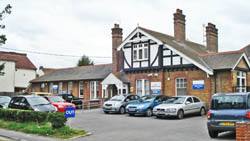
The pretty cottage hospital was extended over the years.
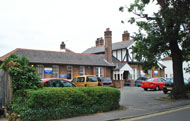
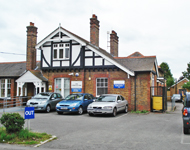
The 1930 extension is shown to the left of the original Hospital building.
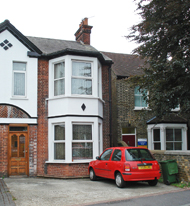
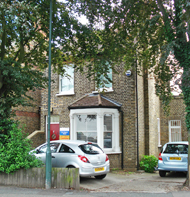
11a Upton Road, the former Nurses' Home.
"I operate the Shropshire War Memorial website and I have some information regarding the nurse who died opposite the Hospital in 1944.
The nurse was Joyce Winifred Rose from Shrewsbury, although she was in London and the surrounding area from 1940. According to a local newspaper report, she was killed by an unexploded anti-aircraft shell which detonated on impact. This was during a bombing raid, but it was a British shell which killed her - a tragic end.
She was laid to rest in Shrewsbury General Cemetery."
Neil Evans
References